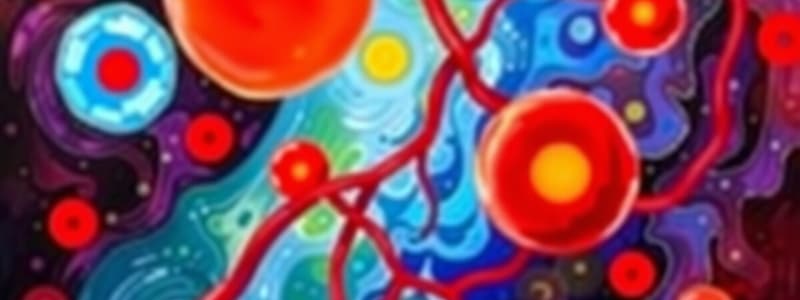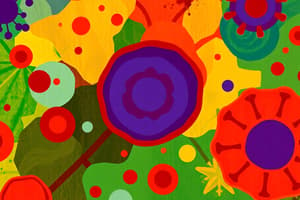Podcast
Questions and Answers
Which component of blood is primarily responsible for transporting oxygen?
Which component of blood is primarily responsible for transporting oxygen?
- Red Blood Cells (RBCs) (correct)
- Platelets
- Plasma
- White Blood Cells (WBCs)
Platelets are responsible for defending the body against invading microbes.
Platelets are responsible for defending the body against invading microbes.
False (B)
What is the role of haemoglobin in blood?
What is the role of haemoglobin in blood?
Binding with oxygen
The fluid part of the blood, which contains dissolved salts and nutrients, is called ______.
The fluid part of the blood, which contains dissolved salts and nutrients, is called ______.
Which of the following is NOT a primary function of blood?
Which of the following is NOT a primary function of blood?
Which of the following statements accurately describes the function of capillaries?
Which of the following statements accurately describes the function of capillaries?
The pulmonary artery is an exception because it carries deoxygenated blood away from the heart to the lungs.
The pulmonary artery is an exception because it carries deoxygenated blood away from the heart to the lungs.
What is the key structural difference between arteries and veins that accounts for the higher blood pressure in arteries?
What is the key structural difference between arteries and veins that accounts for the higher blood pressure in arteries?
The 'lub-dub' sound of the heartbeat is caused by the opening and closing of the ______ in the heart.
The 'lub-dub' sound of the heartbeat is caused by the opening and closing of the ______ in the heart.
Match the type of blood vessel with its primary function:
Match the type of blood vessel with its primary function:
Which of the following accurately describes the role of the pulmonary circuit?
Which of the following accurately describes the role of the pulmonary circuit?
What prevents the mixing of oxygenated and deoxygenated blood in the heart?
What prevents the mixing of oxygenated and deoxygenated blood in the heart?
Veins always carry deoxygenated blood.
Veins always carry deoxygenated blood.
Which of the following BEST describes the relationship between heartbeat and pulse rate?
Which of the following BEST describes the relationship between heartbeat and pulse rate?
A stethoscope amplifies the sound of the heart, allowing doctors to assess its condition.
A stethoscope amplifies the sound of the heart, allowing doctors to assess its condition.
What is the main function of the kidneys in the human excretory system?
What is the main function of the kidneys in the human excretory system?
The two tube-like structures connecting the kidneys to the urinary bladder are called the _______.
The two tube-like structures connecting the kidneys to the urinary bladder are called the _______.
Match each organ with its primary function in the excretory system:
Match each organ with its primary function in the excretory system:
What process is used to filter blood outside the body when both kidneys fail?
What process is used to filter blood outside the body when both kidneys fail?
Root hairs decrease the surface area for the absorption of water and minerals in plants.
Root hairs decrease the surface area for the absorption of water and minerals in plants.
Name the process by which plants make food using carbon dioxide and water.
Name the process by which plants make food using carbon dioxide and water.
Flashcards
Arteries
Arteries
Vessels that carry blood away from the heart.
Veins
Veins
Vessels that carry blood back to the heart.
Capillaries
Capillaries
Tiny vessels where oxygen, glucose, and carbon dioxide diffuse.
Lumen
Lumen
Signup and view all the flashcards
Heart
Heart
Signup and view all the flashcards
Atria
Atria
Signup and view all the flashcards
Ventricles
Ventricles
Signup and view all the flashcards
Pulmonary Circuit
Pulmonary Circuit
Signup and view all the flashcards
Blood
Blood
Signup and view all the flashcards
Red Blood Cells (RBCs)
Red Blood Cells (RBCs)
Signup and view all the flashcards
White Blood Cells (WBCs)
White Blood Cells (WBCs)
Signup and view all the flashcards
Platelets
Platelets
Signup and view all the flashcards
Main Functions of Blood
Main Functions of Blood
Signup and view all the flashcards
Heartbeat
Heartbeat
Signup and view all the flashcards
Stethoscope
Stethoscope
Signup and view all the flashcards
Excretory system
Excretory system
Signup and view all the flashcards
Kidneys
Kidneys
Signup and view all the flashcards
Urinary bladder
Urinary bladder
Signup and view all the flashcards
Ureters
Ureters
Signup and view all the flashcards
Urethra
Urethra
Signup and view all the flashcards
Dialysis
Dialysis
Signup and view all the flashcards
Study Notes
- The circulatory system consists of blood, blood vessels, and the heart.
Blood
- Blood is a fluid tissue that transports nutrients and oxygen to cells, removing carbon dioxide and waste.
- Plasma is the fluid component of blood, containing various dissolved salts and nutrients.
- Blood cells, including red blood cells (RBCs), white blood cells (WBCs), and platelets, are suspended in plasma.
Red Blood Cells (RBCs)
- RBCs transport oxygen throughout the body.
- RBCs contain hemoglobin, a red pigment, which binds with oxygen.
- Hemoglobin gives blood its reddish color.
White Blood Cells (WBCs)
- WBCs defend against invading microbes that may cause illness.
Platelets
- Platelets are the smallest cells in the blood.
- They initiate blood clotting to prevent blood loss from bleeding.
Functions of Blood
- Carries carbon dioxide to the lungs for purification and oxygen from the lungs to the body.
- Delivers digested food to all areas of the body.
- Maintains steady body temperature.
- Transports waste products to the kidneys for excretion.
Blood Vessels
- There are three types: arteries, veins, and capillaries.
Arteries
- Arteries carry blood away from the heart.
- Arteries carry oxygenated blood, except for the pulmonary artery.
- Blood pressure is high in the arteries.
- Arteries have thick, muscular, elastic walls to pump and accommodate blood flow.
- The lumen (channel) of an artery is relatively narrow.
Veins
- Veins carry blood to the heart.
- Veins carry deoxygenated blood, except for the pulmonary vein.
- Blood pressure is low in the veins.
- Veins have thin walls with less muscular tissue than arteries.
- Veins have a wide lumen.
Capillaries
- Capillaries are much smaller than arteries and veins.
- Capillaries are only one cell thick.
- Substances like oxygen, glucose, and carbon dioxide can diffuse through capillary walls.
- Blood pressure is very low in capillaries.
- Gas exchange occurs in capillaries: oxygen passes into tissues, and carbon dioxide passes into the blood.
Heart
- Fist-sized, muscular organ located on the left side of the chest.
- The heart is a vital organ.
- It's divided into four chambers to prevent mixing of oxygenated and deoxygenated blood.
- The top two chambers are the left and right atria.
- The lower two chambers are the left and right ventricles.
- The heartbeat is the contraction and relaxation of the heart's chamber walls.
- Valves in the heart ensure blood flows in one direction.
- The "lub-dub" sound of the heartbeat is caused by the opening and closing of heart valves.
Pulmonary Circuit
- System of veins and arteries that connects the lungs and the heart.
- Blood that has lost oxygen is pumped to the lungs to replenish it.
- Then it returns to the heart to be recirculated.
Pulse
- The pulse refers to the rhythmic contraction and relaxation of heart muscles, producing the "lubb-dubb" sound.
- At rest, the average adult heartbeat is 72-80 beats per minute, increasing during and after exercise.
- The heartbeat rate equals the pulse rate per minute.
Stethoscope
- Instrument used to listen to the heartbeat.
- Used by doctors to amplify sounds of the heart.
- Consists of a chest piece with a diaphragm, two earpieces, and a connecting tube.
Human Excretory System
- The excretory system removes waste products from the body.
Kidneys
- The kidneys filter wastes from the blood, which are then removed in urine.
- Blood capillaries in the kidneys filter blood.
Urinary Bladder
- The urinary bladder stores urine produced in the kidneys.
Ureters
- Ureters are tubes connecting the kidneys to the urinary bladder.
- They transport urine from the kidneys to the urinary bladder.
Urethra
- The urethra is a muscular tube through which stored urine is expelled from the body.
Dialysis
- Dialysis is the filtering of blood outside the human body using a machine when both the kidneys fail.
Transportation in Plants
- Plants require carbon dioxide, water, and nutrients to survive.
- Leaves produce food through photosynthesis, combining carbon dioxide and water.
Root Hair
- Root hairs are elongated extensions of roots, increasing the surface area for water and mineral absorption.
Vascular Tissues
- Vascular tissues are of two types: xylem and phloem.
Xylem
- Xylem transports water and nutrients from the roots to other parts of the plant.
Phloem
- Phloem transports soluble organic material (food) produced during photosynthesis from the leaves to other parts of the plant.
Transpiration
- Transpiration is the evaporation of water through stomata on the leaf surfaces.
- Continuous evaporation creates a suction force that pulls water from roots upward through the plant.
- Transpiration is a necessary process, even though it causes water loss.
- The suction force helps draw water to great heights in tall trees.
- It produces a cooling effect on the plant, preventing damage from sunlight's heat.
- Also helps transport water and minerals to leaves for photosynthesis.
- Transpiration increases in hot, sunny, or windy conditions due to increased evaporation.
- Increased transpiration leads to increased water absorption through the roots.
Studying That Suits You
Use AI to generate personalized quizzes and flashcards to suit your learning preferences.




